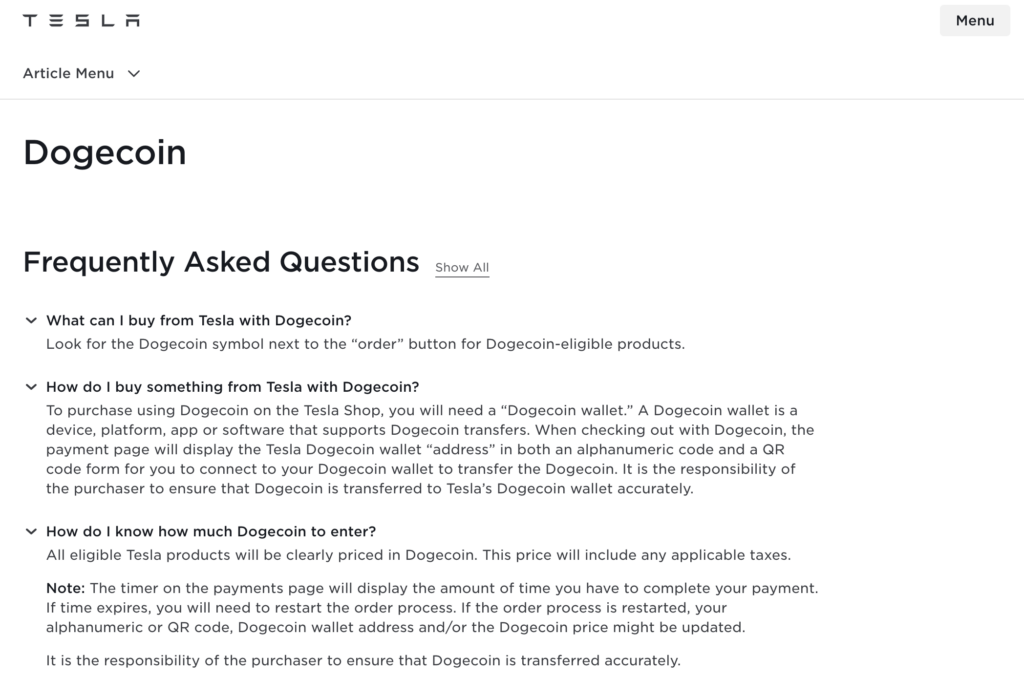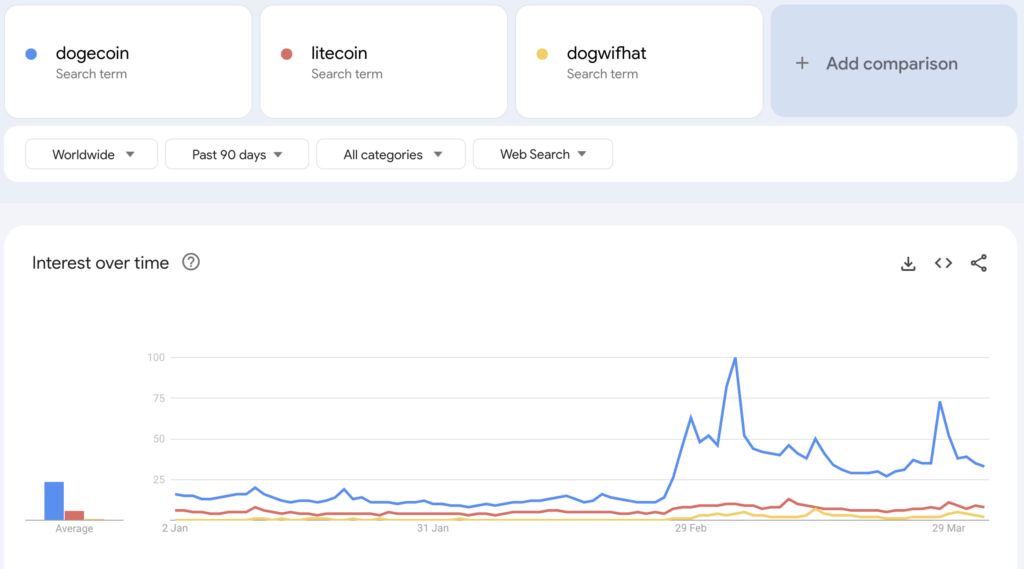In DOGE We Trust – The Wild Ride of the Original Memecoin
Following Bitcoin’s Q1 outperformance, and memecoin mania, DOGE has emerged as one of the best-performing crypto assets YTD. We tell the story of the whimsical cryptocurrency, its current popularity, and why it may remain one of 2024’s best performers.
Dogecoin has always been a joke, but it’s a joke that keeps on giving. Despite being an 11 year old memecoin, Doge is one of the best performing major digital assets year to date (+93%), more people own Doge than at any other time, and Doge is dominating the crypto conversation thanks to the 2024 memecoin phenomenon. Woof.
The Power of a Good Meme
Dogecoin was first launched as a joke, as a satirical caricature of Bitcoin. Doge is based on the Doge meme, which features a Shiba Inu, a Japanese dog breed, making a face.

The DOGE Shiba Inu
Despite its non-serious origin story, Doge has had surprising staying power — capturing a loyal group of followers and growing in value over time. For the most part, this was thanks to the meme community, Twitter users, and Reddit. Collectively these fans formed one of crypto’s biggest and most loyal communities. Dogecoin has famously enjoyed support from Elon Musk, the world’s richest man, who has claimed that users will one day be able to buy Tesla cars with Dogecoin. Fans are currently able to buy Tesla merchandise with Dogecoin.

Source: Tesla
The enduring appeal of Dogecoin lies in its inherent sense of whimsy and fun. Described as an “open-source peer-to-peer digital currency, favored by Shiba Inus worldwide” on its official website, Dogecoin distinguishes itself from other digital asset projects by embracing its playful nature without pretense.
Unlike many cryptocurrencies that espouse grand visions of revolutionizing the world, Dogecoin maintains a refreshingly straightforward approach. There are no lofty pronouncements about changing the course of history; instead, Dogecoin remains true to its origins with a fair launch akin to Bitcoin’s inception. This means no token presale, pre-mine, or venture capital fundraising, ensuring a level playing field for all participants.
Dogecoin lacks the elaborate business development and marketing machinery often found in the cryptocurrency space, eschewing insider benefits in favor of a more egalitarian ethos. As a fork of Bitcoin, Dogecoin benefits from well-established technology, offering reliability despite its lack of novelty. Remarkably, Dogecoin predates even Ethereum, making it one of the oldest altcoins in existence.
Despite its age, Dogecoin continues to captivate the market with its irreverent charm and inclusive community. While its founders may have faded into obscurity, Dogecoin’s legacy endures as a testament to the enduring power of memes.

Source: Google Trends
In fact, as the Google Trends chart above shows, 2024 has been a breakout year for Dogecoin, with worldwide Google search interest in Doge (blue line) experiencing sharp spikes in February and March, far eclipsing Litecoin (red), the token it was forked from, or DogWifHat, the other big memecoin story of 2024. The reason? However improbable it might sound, in Q1 2024, the best performing sector in crypto was memecoins. And Dogecoin, at 11 years old, is seen as the Bitcoin of the memecoins.
Memecoin Mania 2024
Bitcoin has led the crypto market’s move into bull market territory, but it is meme coins that have captured the altcoin zeitgeist this year. While Bitcoin has comfortably outperformed the altcoin markets, there are some exceptions. Most of those exceptions are memecoins. This year’s surprising memecoin rally is a potent demonstration of the power of memes to capture the cultural zeitgeist, and they have come to dominate the current crypto cycle.
Memecoins are an incredibly popular and volatile subset of the crypto markets. Memecoins are blockchain-based tokens that are based on popular pieces of internet culture. They are generally characterized by having minimal utility and extreme volatility. If you identify with cute dogs, the edgy Pepe frog, or President Trump, there is a memecoin for your tribe.

Top crypto narratives in Q1 2024. Source: CoinGecko
The current craze around memecoins is reminiscent of the 2017 ICO bubble, except this time, there’s no illusion of value — the bar has never been lower. Memecoins represent the epitome of both greed and entertainment in the cryptocurrency world.
According to a recent report by CoinGecko, the memecoin sector has emerged as the most lucrative narrative of the year so far. The report reveals staggering average returns of 1,312.6% across the top memecoins by market capitalization. Notably, memecoins launched in March swiftly climbed to become some of the largest by market value by the end of the quarter. Examples include Book of Meme (BOME), Brett, and Cat in a Dogs World (MEW).
BRETT stands out with the highest returns of 7,727.6% by the end of Q1 2024, closely followed by Dogwifhat (WIF), which saw a year-to-date growth of 2,721.2% after gaining popularity during the Solana-based memecoin frenzy which has also propelled BONK to all time highs.
CoinGecko analyst Lim Yu Qian commented, “The memecoin narrative has proven to be significantly more profitable than other crypto narratives, including tokenized real-world assets (RWA) and layer 2 solutions, with returns 4.6 times and 33.3 times higher, respectively, in Q1 2024.”
As of now, the total market capitalization of the memecoin sector stands at $60.93 billion, constituting approximately 2.32% of the total cryptocurrency market capitalization, according to CoinGecko data. This represents a remarkable 176.9% increase quarter-on-quarter.
Interestingly, this market capitalization exceeds that of several mainstream sectors with considerable capital and institutional participation, such as decentralized physical infrastructure networks (DePINs) at $29.98 billion, layer 2 solutions at $32.39 billion, zero-knowledge proofs at $18 billion, and tokenized real-world assets (RWAs) at $8.5 billion.
Dogecoin is the original memecoin. And the fact that it is 11 years old, and now the eighth-largest cryptocurrency by market cap is all the proof anyone should need about the staying power of a good meme.
The History of Doge
In 2013, Jackson Palmer, a member of Adobe Systems’ marketing team, and Billy Markus, an IBM software engineer, joined forces to create Dogecoin. Their inspiration? The internet sensation of the time: the “Doge” meme. Featuring a curious Shiba Inu dog adorned with multicolored Comic Sans text expressing its inner thoughts, the meme captured the hearts of netizens worldwide.
The genesis of Dogecoin can be traced back to November 28, 2013, when Jackson Palmer took to Twitter with a seemingly tongue-in-cheek proclamation: “investing in dogecoin, pretty sure it’s the next big thing.”
Despite its humorous origins, this tweet marked the public emergence of Dogecoin as a cryptocurrency with potential. Following the tweet, Palmer swiftly secured the domain www.dogecoin.com on December 4, 2013, laying the groundwork for what would become a cultural phenomenon.
Two days later, on December 6, the Dogecoin genesis block was mined, officially bringing the cryptocurrency into existence. It wasn’t long before Dogecoin found its first valuation, with the price of DOGE established at $0.001540753 on January 23, 2014, marking the beginning of its journey in the world of digital assets.
The Doge Community Expands
The inception of the r/Dogecoin subreddit on December 8, 2013, marked the beginning of a vibrant online community centered around the beloved cryptocurrency. The first post, “Post addresses in here to share and request dogecoin,” set the tone for a space where enthusiasts could come together to exchange tips and engage in discussions about Dogecoin. By 2014, just months after the genesis block, the subreddit boasted over 35,000 members, reflecting the rapid growth of Dogecoin’s following. Today, r/Dogecoin boasts more than 1.6 million subscribers, a testament to its enduring popularity.
During its early years, the Dogecoin community became known for its charitable endeavors, embodying the spirit of giving and camaraderie. One notable example occurred in 2014 when the Jamaican Bobsled Team qualified for the Winter Olympics after a decade-long hiatus but lacked the necessary funding to participate. Inspired by the film “Cool Runnings,” which depicted a Jamaican bobsled team’s journey to the Olympics, the Dogecoin community rallied together to raise $30,000 worth of DOGE in just a few hours, ensuring the team’s participation in the games.
This act of generosity was just one of many charitable initiatives spearheaded by the Dogecoin community. From supporting Cambodian primary education to providing access to clean water in impoverished regions, Dogecoin enthusiasts consistently demonstrated their commitment to making a positive impact on the world. For founders Jackson Palmer and Billy Markus, Dogecoin was never about personal gain but rather about fostering a sense of community, humor, and altruism. In its early days, Dogecoin epitomized the ethos of cryptocurrency as a force for good, driven by the collective desire to make a difference in the lives of others.
Speculation begins
Dogecoin made its debut during a pivotal moment in the cryptocurrency landscape, coinciding with Bitcoin’s meteoric rise to a new all-time high in the bull cycle preceding the 2017 expansion. Bitcoin’s peak at $1,156.14 on November 30, 2013, occurred just two days after Jackson Palmer’s now-famous tweet proclaiming Dogecoin as the “next big thing.”
As Dogecoin gained traction, exchanges swiftly moved to accommodate its growing popularity. By the end of Dogecoin’s inaugural year, a staggering 33 exchanges had incorporated DOGE trading into their platforms. However, a recent survey indicates that only five of these exchanges remain operational today. These exchanges, listed in order of DOGE listing, include Poloniex (01/22/14), Bittrex (02/13/14), Kraken (02/20/14), HitBTC (06/03/14), and CEX.io (08/20/14).
Despite its initial success, the founders of Dogecoin soon found themselves disillusioned with the direction the cryptocurrency was taking. Originally intended as a lighthearted project, Dogecoin had morphed into a speculative asset, straying from its roots as a crypto “for sillies.” Discomforted by the influx of serious investment, Billy Markus expressed his unease, stating, “when someone puts $20k in… that makes me really, really uncomfortable. I don’t want to be a leader of a cult.” Similarly, Jackson Palmer distanced himself from the project, unsubscribing from the r/Dogecoin subreddit on June 24, 2014. Palmer later announced his departure from the cryptocurrency community altogether in 2015, citing the toxic nature of the ecosystem. Subsequently, he deleted his YouTube and Twitter accounts, severing ties with the digital realm entirely.
Development
Dogecoin, affectionately known as DOGE, traces its lineage through a series of forks originating from Bitcoin. Initially, it was a fork of Luckycoin, itself a fork of Junkcoin, which in turn derived from Litecoin, a fork of Bitcoin.
Dogecoin initially employed the Scrypt hash function for its proof-of-work consensus algorithm, allowing miners to validate transactions on the network. However, in late 2014, Dogecoin transitioned to merge-mining with Litecoin, enabling Litecoin Scrypt miners to simultaneously mine Dogecoin at no additional cost. While mining Bitcoin is out of the realm of possibility for most, it is still possible for individuals to mine DOGE today.
Despite its humorous origins, Dogecoin’s core architecture draws heavily from Bitcoin, inheriting key features such as its scripting language and utilization of unspent transaction outputs (UTXOs). In its early stages, Dogecoin operated independently, employing Scrypt mining and featuring random block rewards inherited from Luckycoin.
However, to enhance its security and stability, Dogecoin later implemented merged mining with Litecoin, adopting fixed block rewards.
While Bitcoin remains the dominant force in the cryptocurrency realm, Dogecoin offers distinct advantages. Unlike Bitcoin, which demands substantial computing power and incurs high transaction fees during peak demand, Dogecoin requires fewer resources for mining, making it more accessible to a broader user base.
Additionally, Dogecoin boasts the largest circulating supply among cryptocurrencies, with its initial supply of 127 million coins incrementing over time. This mass distribution strategy, originally conceived as a joke, has contributed to Dogecoin’s widespread adoption and popularity, despite its price remaining below $1.
Dogecoin’s success defies conventional expectations, embodying the power of humor and community in the cryptocurrency landscape. While initially intended as a parody, Dogecoin has emerged as a formidable contender, driven by its inclusive ethos and widespread appeal.
Litecoin: The Backbone of Dogecoin
Litecoin, born from a clone of Bitcoin in 2011, plays a crucial role in safeguarding Dogecoin through a mechanism known as “merged mining.” Initially conceived as a playful endeavor, the Dogecoin blockchain faced imminent peril in 2014 due to its rapid currency issuance rate, endangering its security. Recognizing this threat, Charlie Lee, the architect behind Litecoin, proposed merged mining, allowing Dogecoin to leverage Litecoin’s robust network security, ultimately coming to the rescue of the embattled cryptocurrency.
While some may perceive Litecoin as a “ghost chain” lacking in innovation, its significance in supporting Dogecoin cannot be understated. The brains behind Litecoin, Charlie Lee, a computer scientist trained at MIT, crafted the network by cloning Bitcoin’s original code, providing a foundation for subsequent projects like Dogecoin.
Dogecoin, conceived by software engineers Billy Markus and Jackson Palmer, faced challenges stemming from deviations in its issuance model, straying from Bitcoin’s established parameters. All three blockchains, including Bitcoin, Litecoin, and Dogecoin, rely on a proof-of-work system, incentivizing miners to secure the network in exchange for block rewards. However, Dogecoin’s issuance model before 2015, characterized by rapid halvings and diminishing block rewards, compromised its network security, leaving it vulnerable to attacks.
In response to the looming threat, Dogecoin underwent a significant transformation in 2014, implementing merged mining or auxiliary proof-of-work (AuxPoW) with Litecoin. This innovative approach allowed miners to secure both blockchains simultaneously, bolstering Dogecoin’s security infrastructure and ensuring its survival.
Merged mining enables miners to secure multiple networks simultaneously, receiving rewards from each without compromising performance. By tapping into Litecoin’s established security, Dogecoin strengthened its defenses against potential attacks, safeguarding its viability in the crypto landscape.
Today, Dogecoin continues to operate with a fixed block reward of 10,000 DOGE and a one-minute block time, with no cap on the total number of coins created. Thanks to merged mining with Litecoin, Dogecoin enjoys enhanced security and stability, ensuring its longevity in the ever-evolving world of cryptocurrencies.
Improving fundamentals
The fundamentals underlying Dogecoin are deserving of attention. The network’s hash rate has surged to unprecedented levels, reaching 724 TH/s, signaling a growing interest in mining DOGE and bolstering support for the network.
Presently, virtually all Litecoin miners are also engaged in DOGE mining, evident from the similar hash power across both networks.
In previous bull cycles, revenue from merge-mining DOGE offered only marginal supplementary income for Litecoin miners. However, the landscape has drastically changed. Today, mining DOGE yields nearly 4.5 times more revenue compared to LTC, and since DOGE’s peak in the bull market at the close of 2021, it has generated at least 1.5 times more revenue. This significant disparity in revenue serves as a strong incentive for miners to prioritize DOGE mining, contributing to the network’s enhanced stability and security.
Dogecoin generates approximately $1 million in daily revenue for miners, with daily revenue peaking at $9.6 million in May 2021. This substantial revenue stream underscores the robustness of DOGE mining operations and highlights its pivotal role in sustaining the network’s integrity and functionality.
Doginals
These trends have been further boosted by the introduction of DRC-20 tokens on the Dogecoin network. A similar trend was observed on Bitcoin earlier in 2023 with the inception of the first inscriptions on the chain. In the ensuing 11 months, Bitcoin’s daily transaction counts and average block size reached all-time highs and have since remained elevated. This surge has bolstered miner revenue, enhanced the overall economic robustness of the network, and sparked a significant wave of interest in the ecosystem.
However, Dogecoin has not yet achieved the same level of consistency in these metrics as Bitcoin. This can be attributed to limited awareness regarding on-chain activities in Dogecoin and the relatively nascent state of supporting infrastructure such as wallets and marketplaces. Nonetheless, the emergence of “Doginals,” a unique phenomenon, has the potential to stimulate demand for DOGE and utilization of the network.
It’s worth noting that the DRC-20 standard operates similarly to the minting and transfer of fungible tokens via the Ordinals protocol on Bitcoin. However, it is acknowledged that this token standard may be inefficient and artificially inflate metrics like transaction count and block size.
Conclusion
While Doge is now too well established with too big a market cap to see the kind of gains that newly released memecoins can sometimes achieve, Doge now has proven staying power, friends in high places, and one final prophecy that is yet to be fulfilled. Doge to a dollar. The Doge all time high is $0.7316, achieved in 2021.
There’s a belief within the community, however, that $1 is achievable this cycle, as referenced by popular X trader Angelo below. Can the prophecy be fulfilled? We’ll find out soon enough. Much wow. Woof.

Source: X

Don’t miss out – Find out more today



